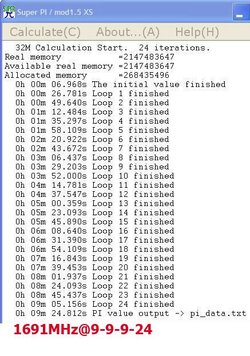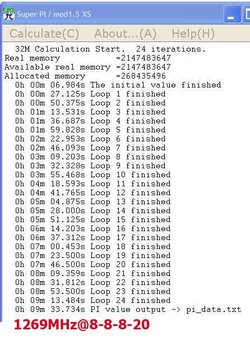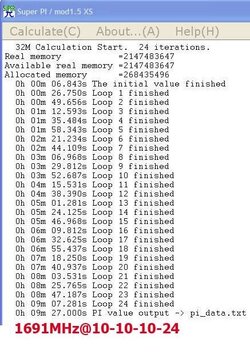- Joined
- Jan 18, 2001
- Location
- Athens - Greece
Very very interesting thread guys, it will help me a lot in my effort to OC i7 even if on a different Mobo!
Welcome to Overclockers Forums! Join us to reply in threads, receive reduced ads, and to customize your site experience!




So now here I am, the CPU is about 25% faster than the fastest CPU "money can buy" today as things go... I'm in a hurry and here's what I was doing and here's how things went: I'm playing music, I'm rendering video files to make a DVD and I have browsers open and I'm trying to open another video file at the same time to take snap shots of it for the DVD menu thumbnail, and all of that at the same time...
the 4 GHz i7 is struggling. It's doing it but I'm exhausting resources somewhere along the way.
So what would make doing all of this snappier?
Switching to a 64-bit OS? Doubling the RAM from 3GB to 6GB? Raw CPU speed? I'm not talking improvements, I'm talking the hypothetical situation of no stuttering whatsoever while doing all of this simultaneously... How would things change with 64-bit OS vs. more RAM vs. more raw CPU speed vs. maybe HD switch from 7200 RPM to Solid State...
For every day use, I've reached the same conclusion after using Vista on my dual boot but could you post a list of reasons that made you personally say no Vista any more.No VISTA anymore ever. No 64 bit and its 3rd party bugs ever.
I would love to do this, I can even replicate the assault on the same machine in Vista since I have a dual boot XP/Vista but what all should I use to set up this experiment and measure it all just for info purposes?You can monitor the load with a variety of tools.
Vista users are the ones with delusions when it comes to denying others observations.3. You say idle RAM is lost in Vista but did they not say that this is a common misconception about Vista and that RAM loss was not what it seemed as the RAM is immediately released as soon as it is needed in Vista?
mobos use controller chips from very few SATA supplying companies, and the companies make drivers that are very backward compatible, and therefore its not hard to slipstream in , or add , AHCI drivers you need onto your bootable media. Some can be installed under windows before you reboot and switch to AHCI.4. Yup Blue Screen of Death with AHCI instead of IDE enabled. When you say "install AHCI support," I'll google it but is the procedure mobo specific?
I used ioMeter from Intel (www.iometer.org), which you can compile yourself but typically is downloaded precompiled. then I setup ioMeter to only use a 20 gigabyte range of blocks to be fair to disk head movement of mission critical database simulation, and used outer edge of disk platters of 4 raptor drives with latest firmware in one of the fastest 1-U rackmounts ever sold at the time with two of the fastest cpus, and the worlds fastest SATA cards at the time going to the 4 drives. The ioMeter was set to do READ of tiny blocks in a random pattern, and io per second was being measured to see if each IO under 7.5 millisecond or so. (15K RPM SCSI 320 drives are under 5) (Random Read IOPS) For over a week I could show full speed on any ONE drive but not with drives NEAR EACH OTHER. I tried suppressing EMI radiation, radio, then assumed magnetic, or other cross noise, power problems , etc etc etc. NOTHING got drives to go full head seek speed. Then I was told to cram two small pieces of accoustic ballistics ear foam on the rails ramming the drives in tight but cushioned by the foam. Thnese were removably mounted drives. All 4 drives got 40% more head seeks per second sustained immediately. Not all drives are probably that crappy. But WD740ADFD Raptors were. I could not use SCSI 320 because I was working for a SATA controller company at the time.5. Re the part about "slow down head seeks over 40%" first off, I don't have raptors just regular 7200 RPMs will that help me? Second, what!?up to 40% increase just by inserting what where? Pics please or links but this is major, why is this not mentioned everywhere? So I'll be definitely following up on that jewel:
1. Tell me what to use to measure this.
2. Help me understand what exactly I am supposed to do to set up this experiment & I'll post pics & results.
Digital photography lovers kept predicting that a digital camera would be BETTER in resolution than a 50 dollar 35 millimeter camera loaded with Kodachrome 25 or 64 (en.wikipedia.org/wiki/Kodachrome) taking a picture of a resolution line test at high noon. They predicted Digital would be better than analog film by 1998, then 2000, then 2002, then 2004, then 2009. it still never happened. 4 THOUSAND alternating black and white thin horizontal lines can be photographed AND COUNTED from one side of a negative to another at any reasonable angle of rotation of the camera. In 2009 the highest resolution DIGITAL camera in the world is still the $22,995 Super 10K-HS www.betterlight.com/superModels.html. It counts green pixels twice and uses RGBG per 4 pixel cel . or rather 10200 x 13600 pixels / 4 (RGBG) = 5,100 x 6,800 REAL resolution in greyscale. If I rotate the target resolution chart a few degrees, the 5,100 lines is NOT ENOUGH to photograph and count the 4000 lines of resolution I can capture on a camera from 1950 clone using 1950s film for 50 dollars. $22,995 in 2009 IS STILL FUZZIER for line count edge to edge than a 50 dollar analog camera. The LIARs never stop.6. Thanks for SCSI info, it makes sense, let me ask you: what do you see as far as the Solid Sate Drive roadmaps go, what do you see in the near future for storage size & speed?
If you had no audio stutters then most of what I discussed does not apply. You seemed to imply your machine was not keeping up.9. Re audio-only stutters, unless I posted up there that I noticed them, I'm trying to think if I did, but I'll definitely pay attention to see if I hear them - then implement your suggestions to address them.
10. Yeah sure I can get Mac OS X installed on my system, I was just looking at how someone was doing it the other month, the only reason I did not look into details is because I could not think of a reason as to why I would want to for personal use... if I can read or hear a useful reason to do so personally, I'd give it a shot. In other words: Mac... OS X... what is it good for?
/QUOTE]
Personally, I've seen most people that switch to using Mac OS X , tend to only want to ever boot into windows 15% of the time or less, and say the same thing you said but the other way around. If you had a mac buddy with a huge pile of software, and you saw enough demos of stuff you'd see what all the excitement is about. Besides you can still have XP windows intermixed with mac windows on the same screen using a Virtual machine such as Parallels. When you double click on a document it launches either a mac or a windows context to run your document in the correct application.
DO NOT DISCUSS WAREZ HERE! This is a bannable offense, but this is only a warning. Thank you for your understanding - IMOG
Vista users are the ones with delusions when it comes to denying others observations.
www.crn.com/software/207001890
stopwatches and ram measuring tools do not lie.
I do not mind 1.5 gig of ram consumed for VISTA if I have 8 gigs or 16 gigs, I was only mentioning to you that for your case, adding 3 gig more and switching to VISTA from an XP flavor would net you only 1.5 truly 100% available free gigs of RAM.
MS KB940105 Hotfix gave back 800 megabytes of lost RAM under Vista, but not all the lost RAM. Example application for the 800 MB = "Company of Heroes mission 6".
But I am talking about wasted RAM not related to disk prefetch or disk cache, but rather truly allocated RAM held in swap. And Vista slurps down nearly 1.5 gigs of it from what I recall reading several times. Some alarmists claim 2GB. Its just a fact that VISTA is a slow resource wasting bloated fiasco when compared to XP.
4> Disk I/O Vibration
A case that VIBRATES ultrasonically will slow down head seeks over 40%. Use acoustic ear foam for gunnery range wedged in both sides if a drive is insert rail mounted. That always restores the missing 40% I/O/sec on Raptor drives for me. The ultrasonic lateral vibration from other head seaks causes a landing miss greater than 1 track, and the drive goes into a different safety head seek mode to increase head seek guess accuracy. You will not read about this secret anywhere because I never mention it. A head VP of Gigabyte showed me the trick and it worked.